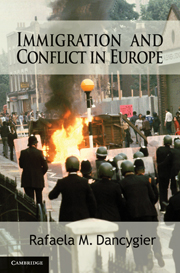Book contents
- Frontmatter
- Contents
- List of Figures and Tables
- Acknowledgments
- PART I GENERAL INTRODUCTION AND THEORETICAL FRAMEWORK
- PART II INTRODUCTION TO PART II
- PART III INTRODUCTION TO PART III
- PART IV INTRODUCTION TO PART IV
- 9 Conclusion
- Appendix A Coding Large-Scale Instances of Immigrant–Native and Immigrant–State Violence
- Appendix B Data and Variables: Immigrant Turnout
- References
- Index
- Titles in the series
PART II - INTRODUCTION TO PART II
Published online by Cambridge University Press: 17 November 2010
- Frontmatter
- Contents
- List of Figures and Tables
- Acknowledgments
- PART I GENERAL INTRODUCTION AND THEORETICAL FRAMEWORK
- PART II INTRODUCTION TO PART II
- PART III INTRODUCTION TO PART III
- PART IV INTRODUCTION TO PART IV
- 9 Conclusion
- Appendix A Coding Large-Scale Instances of Immigrant–Native and Immigrant–State Violence
- Appendix B Data and Variables: Immigrant Turnout
- References
- Index
- Titles in the series
Summary
This book argues that the interaction of local economic scarcity and immigrant political power is at the center of immigrant conflict. As discussed in Chapters 1 and 2, the simplicity of this assertion belies the empirical complexity that one encounters when assembling evidence in support of this claim. One challenge pertains to the isolation of these two central variables. To be convincing, the account offered in this book will have to distinguish economic and political variables from competing factors that may plausibly produce conflict patterns. It will also have to provide good measures of immigrants' political behavior, local economic scarcity, and conflict outcomes.
The evidence put forth in Chapters 3 and 4 represents the first steps in these endeavors. The main goal of these chapters is to show how immigrant groups that share many characteristics, but that have differed in their capacity to amass local electoral clout, have followed different conflict trajectories. West Indian and South Asian migrants arrived in Great Britain around the same time; were subject to the same immigration regime and wider economic trends; enjoyed the same formal political rights; and have occupied similar socioeconomic positions and lived in economically similar towns. Moreover, both groups are ethnically distinct from the majority population and, as I will show, British attitudes were no more acceptant of West Indians than they were of South Asians.
- Type
- Chapter
- Information
- Immigration and Conflict in Europe , pp. 59 - 61Publisher: Cambridge University PressPrint publication year: 2010

